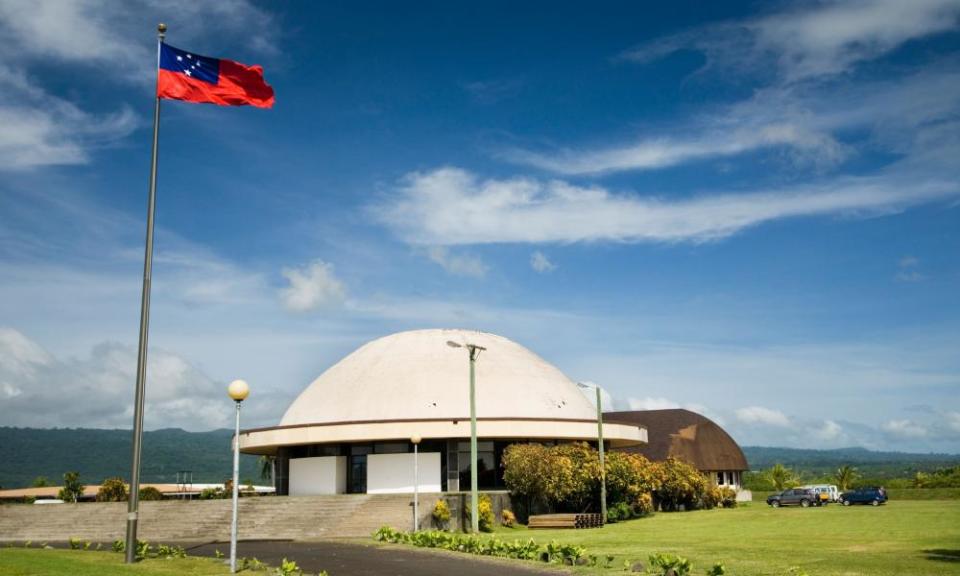No entry: Samoa's new parliament has no place for the press

Samoa’s multi-million dollar parliament house, funded by the Australian government, was built without a press gallery, despite pleas from local media for a space to effectively cover proceedings.
Currently, Samoan journalists are seated in the public gallery, when they are allowed to enter by authorities guarding the parliament.
If we are not in the maota fono then we are hindered from doing our jobs
Maina Vai
Being barred from parliament is a regular occurrence for Samoan journalists, especially for special events and sessions. Often they are seen standing under trees outside parliament waiting to be allowed in, or for sessions to end.
Last week, journalists from TV1, Samoa Global News, 2AP, Talamua, and the Samoa Observer were all barred from entering parliament during a budget session.
“It’s heartbreaking to be treated like this. If we are not in the maota fono – Parliament House – then we are hindered from doing our jobs,” Maina Vai, a senior journalist for Samoa Global News, said.
Vai said journalists were told to stay outside, and were later given chairs and a tent but no means of hearing the discussions in the parliament.
Parliamentary standing orders also strictly forbid cameras in the building and in some instances authorities have discouraged the use of recorders.
“Reporters need to be there during sessions in order to hear and see first-hand the deliberations, with their equipment. Without a proper space to do their work, or permission to take in their equipment, they simply cannot do their job properly,” Rudy Bartley, the president of the Journalists Association of Samoa (JAWS), said.
The International Federation of Journalists (IFJ) said a dedicated press gallery was essential.
“A press gallery and media access to reporting on parliaments is a standard set around the world and considered a fundamental component of a strong and functioning democracy,” said Jane Worthington, director of IFJ Asia Pacific.
“To do otherwise is to disregard this critical pillar – the fourth estate – but also to disregard the needs of the nation’s people to have a watchdog on their democracy.
“Samoa’s media must urgently be given full and appropriate access to parliament to record and report debate and discussions in the national interest. We urge the government to make critical interventions to rectify this worrying situation.”
Related: Australia could include Pacific labourers in 'travel bubble' as $280m aid shake-up revealed
During a 2018 visit to Apia, Australia’s then foreign minister Julie Bishop said Canberra agreed to fund the new parliament building – allocating AU$13.3m – “because democracy matters”.
“We believe that democratic institutions need to be defended, promoted, protected,” Bishop said.
Samoa’s parliament house was built and funded by the Australian government and officially opened in March 2019.
According to JAWS, during the planning of the design of the parliament building, JAWS requested the inclusion of a press gallery with the Australian department of foreign affairs and trade (Dfat).
“When Samoa was offered a new fono building by Australia, there were plans for a press gallery for the media. After many years of inter-government discussion and planning, the gallery plans were said to be in the original plan.

“However when work was to start the press gallery seemed to have disappeared,” said Bartley.
In a description of the parliament building by quantity surveying contractor Rider Levett Bucknall, it included translation and press areas in the plan.
Bartley said when the JAWS asked for an explanation, they were told a gallery for journalists was considered “non-essential” and so dumped from the final plan.
“Local media were not aware of this until it was opened: no gallery was to been seen or heard of again,’ Barley said.
But censorship and challenges to media freedom are not new for Samoa, whose press have faced continuous threats in their line of work. In 2017 the country reintroduced criminal libel in an effort to crack down anonymous bloggers but has far reaching impacts for news media.
In a survey conducted by JAWS and the United Nations Educational, Scientific and Cultural Organisation (UNESCO) in 2019, over 70% of journalists said they had been threatened online, via phone and in person in the pursuit of a story, within in a year of the survey. The main sources of threats were religious leaders and politicians.
Related: Coronavirus in the Pacific: sign up for weekly email updates
Attempts to reach the Office of the Legislative Assembly in Samoa were unsuccessful.
Neither the Australian High Commissioner to Samoa, nor Australia’s minister for international development and the Pacific, Alex Hawke, have not responded to questions from The Guardian.
Lagipoiva Cherelle Jackson is an independent journalist from Samoa.

 Yahoo News
Yahoo News 